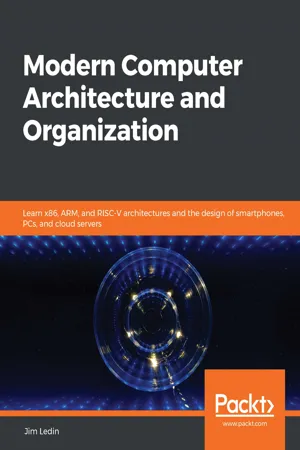
Modern Computer Architecture and Organization
Learn x86, ARM, and RISC-V architectures and the design of smartphones, PCs, and cloud servers
- 560 pages
- English
- ePUB (mobile friendly)
- Available on iOS & Android
Modern Computer Architecture and Organization
Learn x86, ARM, and RISC-V architectures and the design of smartphones, PCs, and cloud servers
About this book
A no-nonsense, practical guide to current and future processor and computer architectures, enabling you to design computer systems and develop better software applications across a variety of domains
Key Features
- Understand digital circuitry with the help of transistors, logic gates, and sequential logic
- Examine the architecture and instruction sets of x86, x64, ARM, and RISC-V processors
- Explore the architecture of modern devices such as the iPhone X and high-performance gaming PCs
Book Description
Are you a software developer, systems designer, or computer architecture student looking for a methodical introduction to digital device architectures but overwhelmed by their complexity? This book will help you to learn how modern computer systems work, from the lowest level of transistor switching to the macro view of collaborating multiprocessor servers. You'll gain unique insights into the internal behavior of processors that execute the code developed in high-level languages and enable you to design more efficient and scalable software systems.The book will teach you the fundamentals of computer systems including transistors, logic gates, sequential logic, and instruction operations. You will learn details of modern processor architectures and instruction sets including x86, x64, ARM, and RISC-V. You will see how to implement a RISC-V processor in a low-cost FPGA board and how to write a quantum computing program and run it on an actual quantum computer. By the end of this book, you will have a thorough understanding of modern processor and computer architectures and the future directions these architectures are likely to take.
What you will learn
- Get to grips with transistor technology and digital circuit principles
- Discover the functional elements of computer processors
- Understand pipelining and superscalar execution
- Work with floating-point data formats
- Understand the purpose and operation of the supervisor mode
- Implement a complete RISC-V processor in a low-cost FPGA
- Explore the techniques used in virtual machine implementation
- Write a quantum computing program and run it on a quantum computer
Who this book is for
This book is for software developers, computer engineering students, system designers, reverse engineers, and anyone looking to understand the architecture and design principles underlying modern computer systems from tiny embedded devices to warehouse-size cloud server farms. A general understanding of computer processors is helpful but not required.
]]>
Frequently asked questions
- Essential is ideal for learners and professionals who enjoy exploring a wide range of subjects. Access the Essential Library with 800,000+ trusted titles and best-sellers across business, personal growth, and the humanities. Includes unlimited reading time and Standard Read Aloud voice.
- Complete: Perfect for advanced learners and researchers needing full, unrestricted access. Unlock 1.4M+ books across hundreds of subjects, including academic and specialized titles. The Complete Plan also includes advanced features like Premium Read Aloud and Research Assistant.
Please note we cannot support devices running on iOS 13 and Android 7 or earlier. Learn more about using the app.
Information
Section 1: Fundamentals of Computer Architecture
- Chapter 1, Introducing Computer Architecture
- Chapter 2, Digital Logic
- Chapter 3, Processor Elements
- Chapter 4, Computer System Components
- Chapter 5, Hardware–Software Interface
- Chapter 6, Specialized Computing Domains
Chapter 1: Introducing Computer Architecture
- The evolution of automated computing devices
- Moore's law
- Computer architecture
The evolution of automated computing devices
Charles Babbage's Analytical Engine
ENIAC
Table of contents
- Modern Computer Architecture and Organization
- Why subscribe?
- Preface
- Section 1: Fundamentals of Computer Architecture
- Chapter 1: Introducing Computer Architecture
- Chapter 2: Digital Logic
- Chapter 3: Processor Elements
- Chapter 4: Computer System Components
- Chapter 5: Hardware-Software Interface
- Chapter 6: Specialized Computing Domains
- Section 2: Processor Architectures and Instruction Sets
- Chapter 7: Processor and Memory Architectures
- Chapter 8: Performance-Enhancing Techniques
- Chapter 9: Specialized Processor Extensions
- Chapter 10: Modern Processor Architectures and Instruction Sets
- Chapter 11: The RISC-V Architecture and Instruction Set
- Section 3: Applications of Computer Architecture
- Chapter 12: Processor Virtualization
- Chapter 13: Domain-Specific Computer Architectures
- Chapter 14: Future Directions in Computer Architectures
- Answers to Exercises
- Other Books You May Enjoy